A courtesan was originally a woman who attends the court of a monarch or other powerful person. In fact, the verb "to court" originally meant "to be or reside at court", and later came to mean "to behave as a courtier" and then "to pay amorous attention to somebody". The most intimate companion of a ruler was called the favourite. Later referred to as the ruler’s mistress.

Sarah Bernhardt ca. 1866 Nadar
Victoria's son Edward VII, who ascended on 22 January 1901, was a much loved king. Although notorious for his many infidelities, each of these affairs were carried out in a kind and discreet manner, which did much to endear him to his subjects. He loved horse-racing, gambling and women! This Edwardian Age was one of elegance. Edward had all the social graces and many sporting interests, yachting and horse-racing. He received criticism for his apparent pursuit of self-indulgent pleasure but at the same time he received great praise for his diplomatic skill, and affable and kind good manners.
 As another colorful ancestor of the future Windsor clan Edward was no exception. The following are some of his most famous ladies...
As another colorful ancestor of the future Windsor clan Edward was no exception. The following are some of his most famous ladies...

"Sarah" Bastien-Lepage

Bertie, an avid theater goer, became enamoured with Sarah. He visited her often at the theater and lavished her with gifts of jewels. He was a frequent guest at her home and they became close friends as well as lovers. Their relationship lasted from 1870 through 1890. She was one of the bevies of beauties seated in the King’s box at "The Abbey" during his coronation.

French poupee with a Barrois look and a very unusual round face. Large cut blue almond shaped and delicately painted eyelashes. Original blonde mohair wig over cork pate. Pierced ears. Original kid leather body. Wearing her original, two-piece white dotted swiss walking suit with matching bonnet. Her aqua bead necklace and antique aqua pin accent the aqua silk ribbon trim in her day dress.

"The Lily of Jersey"
In 1877 a woman of an unusual beauty arrived in London; Mrs. Lillie Langtry, whose nickname was "the Lily of Jersey.” She had great femininity, confidence, and a supreme ambition. Married Edward Langtry, who owned a ship, but was not the rich man she wanted. Still, she used him as a step to climb in London's high society.
+John+Millais1.jpg)
A Jersey Lilly by John Millais
She was admired by magnates and princes, among them, Prince Leopold, Queen Victoria's youngest son. But none of them could maintain their position by Lillie's side when the Prince of Wales fell in love with her. Considered the greatest beauty of her day, Lillie became the Prince of Wales's official mistress.

Bertie showed himself with Lillie in public, everywhere in London. She caused such a splash in Society that on the day that she was presented in Court, Queen Victoria, who usually retired from the festivities early, stayed in order to see "what all of London was talking about."

Alexandra knew about the "Lillie affair" too and she accepted it. She knew that if she complained she would be herself humiliated, so she resigned herself in silence; she even invited Lillie to Marlborough House. Edward remained fond of her through out the years and he even help her to be accepted in the theatre as an actress.

Despite the fact that she lacked any sort of talent, the performances in which she acted sold out. In 1881, she was succeeded by Daisy, Countess of Warwick as Edward's mistress, but she remained friends with the Prince for the rest of his life.

Lillie by John Pointer

"Barrois French Fashion" featuring a kid body with gusset joints;
Swivel head on shoulder plate, cobalt blue glass eyes and all original costume.
The lady in the original oil-on-canvas portrait is no other than Jenny Jerome (Lady Randolph Churchill). This is a painting by one of the greatest American portrait artists of all time, John S. Sargent. But, this painting is quite mysterious as there is no record of a finished portrait till the date although the Sargent studies of Lady Churchill are widely known. Anyway, the necklace worn by Lady Churchill in the painting was a gift to her from King Edward. The dress worn by her would have been very outrageous that time.
She was part of Bertie’s social circle and soon became a close friend. Soon she was sporting the jewelry that he was known to give women that he was intimate with. Although their affair eventually cooled, they remained friends for the rest of their lives.

French fashion poupee by Rohmer. Gorgeous pale bisque with beautiful blue enamel glass eyes enhanced by delicately painted eyelashes. Beautifully shaped closed mouth with lip shading and outline painting. Pierced ears with tiny pink ball earrings. Original ash blonde mohair wig and fully gusseted body. Wearing an antique pink silk french dress with ecru lace overlay and fully pleated hem.... On her head a lovely light grey antique felt hat with pink silk ribbon trim, lace, and antique cloth flowers in white and pink. Antique undergarments and black antique fashion boots.


Daisy Greville, Countess of Warwick ca. 1899
Following her marriage and the birth of her children, she became a socialite, attending lavish parties and gathering. She and her husband were members of the Marlborough House Set, headed by Albert Edward, Prince of Wales. Beginning in 1886, she became involved in affairs with several powerful men, most notably Edward VII. It was not uncommon in the Victorian era for married women of social prominence to become romantically involved with a man higher on the social ladder than her husband. This was often with the husband's knowledge, as it could also assist in his advancing socially or politically, and was considered normal for the times.
 Lady Warwick's affair with Edward VII, lasted until 1898, Her main flaw when acting as a courtesan for powerful men was that she lacked the ability to keep her affairs private, and when involved with a man of wealth and power, she had a distinct habit of divulging it to others. Often, a courtesan could have a prolonged career simply based on that one characteristic. For her indiscretions and this habit, she earned the nickname "The Babbling Brooke", and she was the inspiration for the popular music hall song "Daisy, Daisy".
Lady Warwick's affair with Edward VII, lasted until 1898, Her main flaw when acting as a courtesan for powerful men was that she lacked the ability to keep her affairs private, and when involved with a man of wealth and power, she had a distinct habit of divulging it to others. Often, a courtesan could have a prolonged career simply based on that one characteristic. For her indiscretions and this habit, she earned the nickname "The Babbling Brooke", and she was the inspiration for the popular music hall song "Daisy, Daisy".

Following the Death of Edward VII, and having large debts, she tried to blackmail his son, the new King George V. She threatened to make public a series of love letters written by Edward VII. It was the cunning expertise of the Private Secretary that managed to stop publication by arguing that copyright belonged to the King. Daisy found herself outmaneuvered and died virtually penniless.

Wax figures borrowed Madame Tussaud’s show us a young Winston Churchill hobnobbing with his betters, Daisy preparing for the evening soirée, and Edward, Prince of Wales, enjoying a cigar and brandy.

Closed-mouth J.D. Kestner, a perfect socket head model upon a bisque shoulder plate, the head is simply impressed 15. Details include gorgeous bisque with exquisite painting, blue glass sleep eyes and a lovely human hair wig, all on a hinged kid body with lower bisque arms.Beautifully costumed as a lady, with a marvelous hat and antique leather heeled boots complete the sublime presentation.

Alice Frederica Keppel, (29 April 1868 - 11 September 1947)
Was a British socialite and the most famous mistress of Edward VII. Pretty, articulate, and discreet, Keppel quickly climbed the society ladder through affairs with prominent men of the day. Known as a very attractive woman, her extramarital affairs were usually initiated by her desire to gain a better social status.

Her success as a courtesan has tended to eclipse any accomplishments of her husband. Most of her affairs were conducted with his full knowledge. Edward VII even visited her house on a regular basis, her husband conveniently leaving during the visits.

The Prince was fifty-six and Alice twenty-nine. She was an accomplished bridge-player, which appealed to him. "She not only had a gift of happiness but she excelled in making others happy," said a contemporary. Queen Alexandra is said to have preferred the discreet Mrs. Keppel to the Prince's previous mistress. In 1910, when Edward VII was dying and asked for Alice's presence,
Edward's wife
Alexandra of Denmark was on good enough terms with Keppel to send for her and to permit her at Edward's side when the King was on his deathbed.
The Keppel-family rose to renewed prominence with the marriage of Alice's great-grand-daughter, Camilla Parker-Bowles (nee Shand) to Charles, Prince of Wales in April 2005.

Unmarked french fashion poupee... probably by Barrois. Cobalt blue, spiral glass eyes. Closed mouth. Pierced ears with turqoise ball earrings. On an antique, fully gussetted french fashion kid body. Brown antique wig with.Wearing a lovely 2pc white dimity dress with a gorgeous layered pleated skirt accented by a turquoise beaded necklace. On her head a lovely white straw fashion hat trimmed in aqua silk and white ostrich feathers...

Courtesans were usually well-educated and worldly. They were typically chosen on the basis of their beauty, "breeding"—social and conversational skills, intelligence, common-sense, and companionship. They were expected to be well-dressed and ready to engage in a variety of topics ranging from art to music to politics.
In some cases, courtesans were even married to husbands lower on the social ladder than their clients. In these cases, their relationships had the potential to improve their spouses' status -– and so, it was not unusual that the husband was aware of his wife's profession and dealings. Affairs of this sort would often be short-lived, ending when either the courtesan or the courtesan's spouse received the status or political position desired.
More often than not a woman serving as a courtesan, would last in that field only as long as she could prove herself useful to her companion. But few lasted long, and after serving a prince or king there was nowhere to go but down.

Madame Du Barry was one of the most famous Courtesans of France and the Mistress of the former King Louis XV.
She was of humble origins – a fact that made Marie Antoinette, as the new Dauphine, cold-shoulder her. However, due to her association with the King of France, Madame Du Barry for a long time enjoyed a high status and privileged position in the French Court.
The French Revolution broke out in 1789 and in the Reign of Terror that followed, scores of hapless people, whose only crime was of being of aristocratic stock or associated in some manner with the royalty, ended their lives on the guillotine. A prominent victim was Madame Du Barry, She was accused of treason and quickly sentenced to death, her final moments were neither peaceful nor dignified.
As she was dragged before the blood-thirsty mob in the Place de la Concorde to be guillotined, she screamed and shouted and wept and begged for mercy. She tried to cling to life until the last, famously crying to the executioner, "Encore un moment, monsieur le bourreau, un petit moment!" (Another moment, Mr. Executioner, just a little moment).

Queen Alexandra stands next to King Edward VII at his coronation. The coronation was originally scheduled for June 26th, 1902, but Edward had to undergo an emergency operation, so it was postponed until August 9th, 1902.
Through his many dalliances, Edward succeeded in changing the strict protocol of the preceding Victorian era. Edward loved the crowds, he travelled extensively and he met people from all backgrounds. He brought back color, and pageantry to a country ruled by an invisible queen,
a country that had sorely missed the presence of their sovereign during Victoria’s extensive mourning period.

 Louis XIV wanted all of Europe to know about Paris fashions so he began sending life-sized fashion dolls to every European Court. The dolls were dressed in the latest styles. Noble ladies would have their tailors imitate the clothes, footwear, hats and accessories on the latest dolls.
Louis XIV wanted all of Europe to know about Paris fashions so he began sending life-sized fashion dolls to every European Court. The dolls were dressed in the latest styles. Noble ladies would have their tailors imitate the clothes, footwear, hats and accessories on the latest dolls.
 E. Barrois, France...One of the earliest French doll factories was owned by Mme Barrois and was based in the Rue St. Martin, Paris. This is a fine example of her work.
E. Barrois, France...One of the earliest French doll factories was owned by Mme Barrois and was based in the Rue St. Martin, Paris. This is a fine example of her work.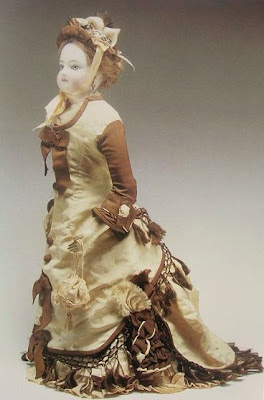 Francois Gaultier ca. 1875...featuring "polonaise" walking dress
Francois Gaultier ca. 1875...featuring "polonaise" walking dress Jumeau, ca. 1880
Jumeau, ca. 1880 Exquisite French cabinet size doll with trunk and accesories, including:
Exquisite French cabinet size doll with trunk and accesories, including: Articulated pale bisque shoulder head on articulated wooden body..possibly Bru.
Articulated pale bisque shoulder head on articulated wooden body..possibly Bru.


 The most facinating thing about a doll is its face, and no amount of technical ingenuity in the construction of the body, or sumptuous clothes can make up for a face that lacks charm.
The most facinating thing about a doll is its face, and no amount of technical ingenuity in the construction of the body, or sumptuous clothes can make up for a face that lacks charm. 18th century fashion required a lot of work. Some went to such lengths that the following rather panicky law was proposed in 1770 (but thankfully never passed):
18th century fashion required a lot of work. Some went to such lengths that the following rather panicky law was proposed in 1770 (but thankfully never passed):




 "Broken Doll"
"Broken Doll"

 The demise of the French Fashion resulted from the rising popularity of the French Bisque child doll which were made to represent children. These dolls know as Bébés started to gain popularity in the 1880's
The demise of the French Fashion resulted from the rising popularity of the French Bisque child doll which were made to represent children. These dolls know as Bébés started to gain popularity in the 1880's The Minuet has a distinctive rhythm with a gentle rising and falling movement in each bar of music. It is danced lightly on the balls of the feet, with the heels only just off the floor and the feet turned out slightly, and each step sequence is accompanied by low, rounded arm movements, in opposition to the movements of the legs. Some dances involve complex and quick footwork, in a series of low springs and hops. Others are slow and stately.
The Minuet has a distinctive rhythm with a gentle rising and falling movement in each bar of music. It is danced lightly on the balls of the feet, with the heels only just off the floor and the feet turned out slightly, and each step sequence is accompanied by low, rounded arm movements, in opposition to the movements of the legs. Some dances involve complex and quick footwork, in a series of low springs and hops. Others are slow and stately.


















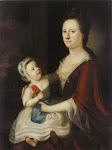

























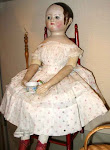.jpg)









































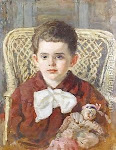





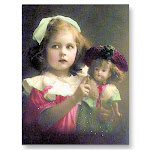










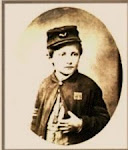















+John+Millais1.jpg)




















